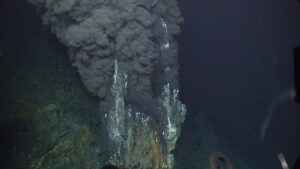Microbial communities living near hydrothermal deep-sea vents hold vast potential for bioenergy.

Deep beneath the ocean, mineral-rich hydrothermal fluid mixes with ocean water and forms chimney structures. Image courtesy of Woods Hole Oceanographic Institute and NSF.
The Science
Hydrothermal vents are ocean-floor openings in the Earth’s crust that emit hot, mineral-rich water. These vents are too deep in the sea to get any sunlight, and yet they still support a unique array of microorganisms adapted to living in extreme conditions. At these vents, and underwater volcanoes, researchers studied microbial communities across five oceanic regions. In doing so, they found a high degree of variability in the types of microorganisms that inhabit these sites, as well as the way in which those microorganisms break down nutrients, grow and repair themselves or eliminate waste.
The Impact
The bacteria, archaea and other microorganisms of the microbial communities around these vents survive in very hot, high-pressure and chemically-rich ecosystems. This means they hold clues for understanding how life thrives in extreme environments. They also produce a range of novel enzymes and other biomolecules that could potentially be applied to biotechnology and medicine. A more robust understanding of these microbial communities could lead to the development of new biotechnologies around clean energy, biofuels and bioproducts.
Summary
Hydrothermal vents are typically found along mid-ocean ridges where tectonic plates pull apart. As those plates separate, seawater seeps through cracks in the Earth’s crust and reacts with very hot rocks below, becoming an extremely hot, mineral-rich hydrothermal fluid. Eventually, that fluid is expelled back into the ocean through vents at temperatures that can exceed 750 degrees Fahrenheit. The minerals in these fluids include sulfur, iron and copper. Larger organisms like shrimp and crabs also live near these vents, feeding on the bacteria and other microorganisms that live there.
Researchers from Portland State University and the University of Wisconsin-Madison collected 40 samples from five oceanic regions to better understand how these hydrothermal ecosystems function in such extreme conditions. They identified 511 new or recently discovered genera of bacteria and archaea. Many of the samples shared a high prevalence of genes involved in sulfur and nitrogen metabolism, as well as those that play a role in carbon cycling.
However, the high degree of variability in what types of microorganisms were found at each site and the role they fulfilled suggest that specific environmental conditions — like temperature, pH levels or the availability of certain nutrients — influence the makeup and functioning of a given microbial community.
Scientists with the U.S. Department of Energy Joint Genome Institute, a DOE Office of Science User Facility at Lawrence Berkeley National Laboratory, contributed metagenomic sequencing to the study as well as genome analysis, providing authors a more complete picture of the taxonomic composition and metabolic potential of the communities studied. The datasets are available on the JGI’s Integrated Microbial Genomes & Microbiomes (IMG/M) portal.
The study, published in the Microbiome journal, broadens our understanding of the unique microorganisms and metabolisms represented in hydrothermal vent communities, with possible applications in biogeochemical engineering, biofuel production and more.
Contacts
BER Contact
Ramana Madupu, Ph.D
Program Manager
Biological Systems Sciences Division
Office of Biological and Environmental Research
Office of Science
Department of Energy
[email protected]
PI Contact
Anna-Louise Reysenbach
Portland State University
[email protected]
JGI Contact
Emiley Eloe-Fadrosh
Metagenome Program Lead
DOE Joint Genome Institute
[email protected]
Funding
This work was funded by the US-National Science Foundation grants OCE-0728391, OCE-0937404, OCE-1558795 to A-L.R, and OCE-2049478 and DBI-2047598 to K.A. We thank the Department of Energy Joint Genome Institute (Community Science Program award 339, lead Peter Girguis) for sequencing several of the samples.
Publication
Zhou, Z., St. John, E. et al. “Global patterns of diversity and metabolism of microbial communities in deep-sea hydrothermal vent deposits.” Microbiome 10, 241 (2022). https://doi.org/10.1186/s40168-022-01424-7
Relevant Links
- CSP Proposal: Why sequence a metagenomic survey of hydrothermal vents?
- Linking mantle to microbe: a community-wide effort to ally hydrothermal vent microbial identity and ecology to geochemical cycles via metagenomics
- Science Highlight: Protein studies offer clues on how palm worms can take the heat
Byline: Menaka Wilhelm